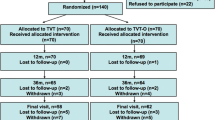Abstract
Introduction and hypothesis
We compared cure rates of tension-free vaginal tape (TVT) with intravaginal slingplasty (IVS) and evaluated changes in cure rates over time.
Methods
One hundred three underwent TVT and 213 underwent IVS. Follow-ups were done at 3 months, 1 year, and 5 years.
Results
The following results were found: objective cure for TVT 98–95–94% vs. IVS 86–86–80% (p < 0.03); subjective cure for TVT 82–79–74% vs. IVS 79–81–71% (NS). In IVS, a significant decline in subjective cure took place. Vaginal erosions were found in 11.8% of women in the IVS group and none in the TVT group.
Conclusions
TVT is an effective and stable treatment, whereas IVS has a significant inferior objective cure rate, and a significant decline in subjective cure rate occurred over time. A high rate of vaginal erosions was found in the IVS group. We cannot recommend the use of multifilament polypropylene tape (IVS) for surgical treatment of stress urinary incontinence.

Similar content being viewed by others
Abbreviations
- TVT:
-
tension-free vaginal tape
- IVS:
-
intravaginal slingplasty
- SUI:
-
stress urinary incontinence
- NS:
-
not significant
- BMI:
-
body mass index
- VE:
-
vaginal erosion
- PVR:
-
postvoid residual urine
References
Amid PK (1997) Classification of biomaterials and their related complications in abdominal wall hernia surgery. Hernia 1:15–21
Novara G, Ficarra V, Boscolo-Berto R, Secco S, Cavalleri S, Artibani W (2007) Tension-free midurethral slings in the treatment of female stress urinary incontinence: a systematic review and meta-analysis of randomized controlled trials of effectiveness. Eur Urol 52:663–679
Sivaslioglu AA, Unlubilgin E, Dölen I (2008) The multifilament polypropylene tape erosion trouble: tape structure vs. surgical technique. Int Urogynecol J 19:417–420
Glavind K, Larsen T (2008) Long-term follow-up of intravaginal slingplasty operation for urinary stress incontinence. Int Urogynecol J 19:1081–1083
Persson J, Bergqvist CE, Wølner-Hanssen P (2001) An ultra-short perineal pad-test for evaluation of female stress urinary incontinence treatment. Neurourol Urodyn 20:277–285
Abrams P, Cardozo L, Fall M (2002) The standardization of terminology of lower urinary tract function: report from the Standardization Sub-committee of the International Continence Society. Neurourol Urodyn 21:167–178
Ghoniem G, Stanford E, Kenton K (2008) Evaluation and outcome measures in the treatment of female urinary stress incontinence: international urogynecological association (IUGA) guidelines for research and clinical practice. Int Urogynecol J 19:5–33
Bump RC (1996) The standardization of terminology of female pelvic organ prolapse and pelvic floor dysfunction. Am J Obstet Gynecol 175:10–17
Nilsson CG, Palva K, Rezapour M, Falconer C (2008) Eleven years prospective follow-up of the tension-free vaginal tape procedure for treatment of stress urinary incontinence. Int Urogynecol J 19:1043–1047
Ankardal M, Heiwall B, Lausten-Thomsen N, Carnelid J, Milsom I (2006) Short and long-term results of the tension-free vaginal tape procedure in the treatment of female urinary incontinence. Acta Obstet Gynecol Scand 85:986–992
Dietz HP, Ellis G, Wilson PD, Herbison P (2004) Voiding function after tension-free vaginal tape: a longitudinal study. Aust N Z Obstet Gynecol 44:152–155
Sander P, Sørensen F, Lose G (2007) Does the tension-free vaginal tape procedure (TVT) affect the voiding function over time? Pressure-flow studies 1 year and 3 1/2 years after TVT. Neurourol Urodyn 26:995–997
Glavind K, Bjørk J, Nøhr M, Jaquet A, Glavind L (2006) A prospective study on whether a tension-free urethropexy procedure affects the residual urine and flow up to 4 years after the operation. Acta Obstet Gynecol 85:982–985
Doo CK, Hong B, Chung BJ, Kim JY, Jung HC, Lee KS, Choo MS (2006) Five-year outcomes of the tension-free vaginal tape procedures for treatment of female stress urinary incontinence. Eur Urol 50:333–338
Basok EK, Yildirim A, Atsu N, Gurbuz C, Tokuc R (2006) The surgical results of the pubovaginal sling procedure using intravaginal slingplasty (IVS) for stress urinary incontinence. Int Urol Nephrol 38:507–512
Kim JC, Chung BS, Choi JB, Lee JY, Lee KS Park WH (2007) A safety and quality of life analysis of intravaginal slingplasty in female stress incontinence: a prospective, open label, multicenter, and observational study. Int Urogynecol J 18:1331–1335
Rechberger T, Rzezniczuk K, Skorupski P, Adamiak A, Tomaszewski J, Baranowski W, Jakowicki JA (2003) A randomized comparison between monofilament and multifilament tapes for stress incontinence surgery. Int Urogynecol J 14:432–436
Meschia M, Pifarotti P, Bernasconi F, Magatti F, Viganò R, Bertozzi R, Barbacini P (2006) Tension-free vaginal tape (TVT) and intravaginal slingplasty (IVS) for stress urinary incontinence: a multicenter randomized trial. Am J Obstet Gynecol 195:1338–1342
Lim YN, Muller R, Corstiaans A, Dietz HP, Barry C, Rane A (2005) Suburethral slingplasty evaluation study in North Queensland, Australia: the SUSPEEND trial. Aust N Z J Obstet Gynecol 45:52–59
Bafghi A, Valerio L, Benizri EI, Trastour C, Benizri EJ, Bongain A (2005) Comparison between monofilament and multifilament polypropylene tapes in urinary incontinence. Eur J Obstet Gynecol 122:232–236
Kulseng-Hanssen S, Husby H, Schiøtz HA (2008) Follow-up of TVT operations in 1113 women with mixed urinary incontinence at 7 and 38 months. Int Urogynecol J 19:391–396
Chen H-Y, Ho M, Hung Y-C, Huang L-C (2008) Analysis of risk factors associated with vaginal erosion after synthetic sling procedures for stress urinary incontinence. Int Urogynecol J 19:117–121
Petros P (2007) Monofilament and multifilament tape usage in incontinence surgery. Am J Obstet Gynecol 196(2):e12
Balakrishnan S, Lim YN, Barry C, Corstaiaans A, Kannan K, Rane A (2007) Sling distress: a subanalysis of the IVS tapes from the SUSPEND trial. Aust N Z J Obstet Gynecol 47:496–498
Bafghi A, Benizri EI, Trastour C, Benizri EJ, Michiels J-F, Bongain A (2005) Multifilament polypropylene mesh for urinary incontinence: 10 cases of infections requiring removal of the sling. BJOG 112:376–378
Conflicts of interest
None.
Author information
Authors and Affiliations
Corresponding author
Rights and permissions
About this article
Cite this article
Prien-Larsen, J.C., Hemmingsen, L. Long-term outcomes of TVT and IVS operations for treatment of female stress urinary incontinence: monofilament vs. multifilament polypropylene tape. Int Urogynecol J 20, 703–709 (2009). https://doi.org/10.1007/s00192-009-0844-7
Received:
Accepted:
Published:
Issue Date:
DOI: https://doi.org/10.1007/s00192-009-0844-7




